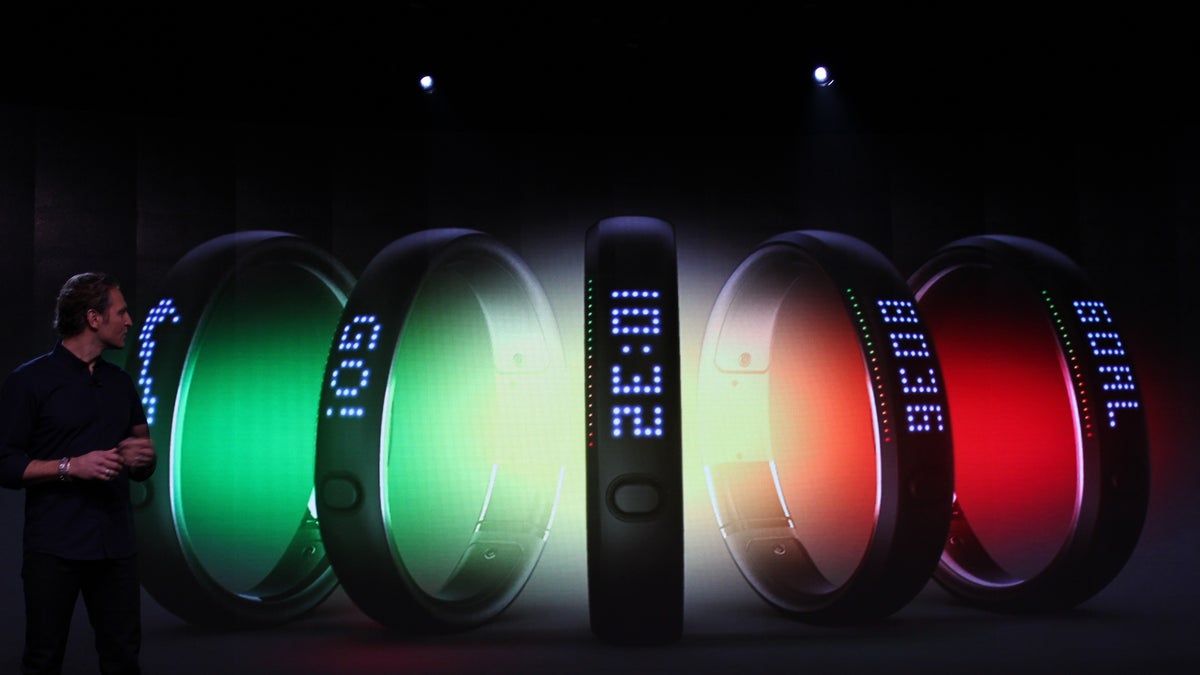Nike unveils its FuelBand activity-tracking device
Nike is pushing a new "universal currency" to measure activity called NikeFuel, which consumers can track using a specially designed wristband.

Nike today introduced its FuelBand wristband device, which is designed to measure a person's daily movement and drive the athletic gear company further into the technology world.
The FuelBand is designed to provide users with the time, the number of steps taken in a day, and calories burned. But the main selling point is a newly created fitness metric called NikeFuel, which is based off the rate of oxygen consumption and motion. The wristband will retail for $149, and is available on February 22 in the U.S., May 1 in the U.K., and the rest of the world in the fall.
The FuelBand represents the next step for a company that waded into the connected devices world with its Nike Plus products, which were designed to track how far and fast runners went. (The company plans to have its Nike Plus products start offering NikeFuel readings in the summer.) But with NikeFuel and FuelBand, the company is fully embracing a world where its products integrate with smartphones, PCs, social media, and the Internet. Nike's pitch to athletes is the FuelBand doesn't just track runners; it measures all activity.
"Before, there was no simple metric that worked across different activities," said Stefan Olander, vice president of digital sports for Nike, who boasted that NikeFuel was based on a scientifically validated method of measuring oxygen consumption.
A normal day of activity, for instance, would provide 2,500 points of NikeFuel, while a high-energy day would provide 5,500.
Nike's attention to the metric is what the company believes will be the key to the FuelBand's success. Users get positive feedback from the accompanying free smartphone app when they hit certain benchmarks. For instance, they get a message saying you're "on fire" when you hit a certain score. Users are also encouraged to share their scores through social media and the Web, although Olander acknowledged that the extent of sharing depends on the comfort level of individuals.
"Some people have no issues sharing, others don't want to share anything except for a completed run," he said. "We make it easy for you to choose your option."
Nike put a decent amount of weight behind this launch, tapping Jimmy Fallon to host the press conference and trotting out cycling legend Lance Armstrong, NBA star Kevin Durant, and track star Carmelita Jeter to talk about the benefits of the FuelBand.
The product itself is a slim wristband that does its job of staying virtually invisible until you absolutely need it. There's an accelerometer in the device that tracks your hand movement, which is matched to data on oxygen consumption taken during several different types of activities, allowing the FuelBand to measure just how active you are. It doesn't always work; activities where your hand is moving little, such as cycling, wouldn't register with the device.
Beyond the four major readouts, there is a smaller strip of LED lights below the main display that goes from red to yellow to green--depending on how far along you are on the activity goals you set. Red means you're not doing enough; green means you're having a pretty active day.
For now, the FuelBand only works with the iPhone; an Android application is in the works for the next few months, and Nike doesn't have plans for other platforms yet.
Glenn Gaesser, a professor at Arizona State University's school of nutrition and health promotion, said the device could be useful in promoting activity, and more importantly, discouraging inactivity, which has led to a number of health problems. The FuelBand's motivational techniques are in line with what the government and health organizations have been pushing in terms of increased daily activity.
Gaesser worked with Nike to help gather the data on the various activities.
Still, at $149, the product will attract primarily fitness enthusiasts with a decent amount of disposable income. The FuelBand finds itself in the category of niche activity products that integrate different kinds of technologies, including an accelerometer, Bluetooth capabilities, and other features. Competing products include Motorola Mobility's MotoActv fitness tracker, which also incorporates more features such as GPS, a music player, and more memory, but for a pricier $249.99.
Olander justified the price of the FuelBand, which is more expensive than some of Nike's shoes, saying the user pays not just for the device, but the experience around it.
"What you're buying into is the band and the experience that follows you all day," Olander said.
Updated at 9:36 a.m. PT: with additional information on how the FuelBand works and comments from a health and fitness professor.

